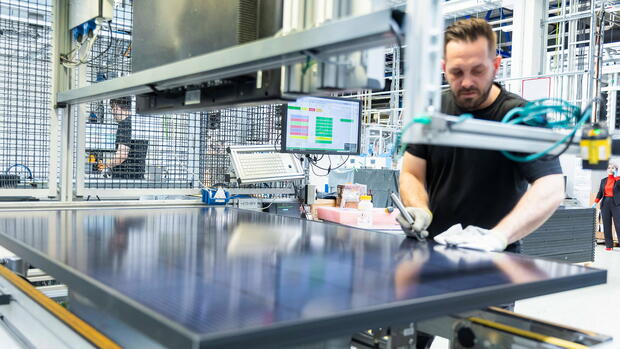Dusseldorf The warning is drastic: “If nothing happens now, there is a great risk that European solar producers will have massive problems in the next few months, and some will even go bankrupt,” says a letter from European solar companies to the Presidents of the European Parliament and the European Commission from Monday. The letter is available to the Handelsblatt.
40 companies from all over Europe signed. These include the Swiss solar cell manufacturer Meyer Burger, which has a production facility in Freiberg, Saxony, the German module producer Heckert Solar and the start-up Nexwafe.
The reason is the rapidly falling prices for photovoltaic modules. They have fallen by more than 35 percent to 15 cents per watt within six months. “The entire European solar industry has been the victim of an unprecedented price war for several months,” says Meyer Burger boss Gunter Erfurt.
Chinese suppliers sold their modules in Europe at up to 50 percent below the production costs in China and thus significantly below those of European manufacturers. Erfurt warns that the goal of rebuilding a European solar industry is not even remotely achievable.
After their meeting last week, the heads of government of the EU member states also spoke of “anti-competitive practices” by Chinese solar companies. In their final letter they stressed the “need to formulate an appropriate common European response”.
Bankruptcies, production stops, short-time work
Meanwhile, the first companies are going bankrupt. The ailing wafer manufacturer Norwegian Crystals filed for bankruptcy a few weeks ago. Norsun, a Norwegian manufacturer of so-called ingots and wafers, announced just last week that it would stop production and announce job cuts. Meyer Burger has supply contracts with both companies. The cell producer now has to get its wafers outside of Europe.
Industry circles are hearing that German module manufacturers are now also introducing short-time work and reducing production in order to save money. According to information from European photovoltaic producers, there are currently more than 500 megawatts of solar modules in their own warehouses, 30 percent more than usual.
They criticize that it is currently simply not possible to sell domestic products at a cost-covering level – especially because of the cheap competition from China. According to the management consultancy McKinsey, production costs there are actually around 20 cents per watt. The current average price on the market is but five cents less.
>> Read also: Industrial electricity price could slow down the expansion of renewable energies
“Chinese companies are offering European customers two-year contracts with prices even below 15 cents per watt. However, these offers are tied to a purchase guarantee of two megawatts per year,” the manufacturers write in their letter. The warehouses are more than full with an estimated 40 gigawatts of Chinese modules.
The drop in prices has several reasons, says Henning Rath from the solar service provider Enpal. He manages purchasing for Germany’s largest photovoltaic distributor from China. The corona pandemic created a “ketchup bottle effect”. “Because of the supply chain problems, everyone has restocked their warehouses as a precautionary measure. At the same time, the energy crisis has driven up demand sharply. “Demand is now returning to normal and warehouses are full,” says Rath.
Prices are currently below estimated production costs.
(Photo: Reuters)
In addition, there is currently much more production capacity for solar modules than for other important components such as ingots and wafers. This is also a reason for the price decline, “which will certainly be accompanied by market consolidation.”
Massive overcapacity reduces prices
While global production capacity was around 200 gigawatts five years ago, it is now 800 to 900 gigawatts. However, industry experts estimate that global demand is only 400 to 500 gigawatts. Most of the production capacity is in China.
“If we talk about overcapacity, the price naturally goes down a bit,” said Zhenguo Li, head of the world’s largest solar manufacturer Longhi, in an interview with Handelsblatt. Of course, “here again, a few companies will not be able to keep up with this price competition”.
European manufacturers only have two options, the solar industry’s letter says: either stop production and go into controlled bankruptcy or move to the USA and other regions of the world, where the development of their own photovoltaics industry is encouraged.
Cell producer Meyer Burger has already stopped its production expansion in Germany after receiving a commitment from the USA’s billion-dollar subsidy program, the Inflation Reduction Act, and instead concentrated all available resources on building a new factory in North America.
>> Read here: Their technology is supposed to save the climate, but Europe is taking too long: companies like Marvel Fusion are relying on the USA
The proposed solutions to the dilemma facing the European solar industry vary. While the European Solar Association is proposing a kind of solar manufacturing bank that brings together producers and buyers from Europe with the best offers and settles the difference with money from Brussels, the 40 solar producers are calling for an emergency purchase of their own stocks by the EU and an immediate import ban of solar modules that were manufactured using forced labor.
This is primarily aimed at producers in China. According to human rights organizations, members of the Muslim Uyghur minority have to do forced labor in the Xinjiang region – including for parts of the solar industry.
Collaboration: Silke Kersting
More: For two billion euros: Solar companies want to set up photovoltaic production in Germany
